British and European Car Spotters Guide - 1959 |
|
 |
|
|
It was estimated, in the autumn of 1959, that one in every three families in Great Britain owned a car. With attractively-priced new models reaching the showrooms and production figures continuing to rise rapidly, the position looked encouraging as Britain prepared to move into the sixties. Of the year's total car production of 1,231,414, no fewer than 568,971 were exported, valued at £222,531,517; UK registrations accounted for 662,443 (including hackneys). The number of imported cars had also risen-26,998 compared with 10,940 for the previous year. Apart from anything else, 1959 was the year of the Mini. This incredible little car started its very successful run in the summer and was an immediate hit with rich and poor alike. Also new to the public were the Aston Martin DB4, the BMC 1½-litre 'Farina' range, Bristol 406, Daimler SP250, Rover 3-Litre, Sunbeam Alpine and Triumph Herald.
All New Aston Martin
One of the most exciting of the Britons for 1959 was the David Brown group's Aston Martin DB4. In contrast to the earlier DB2 and 2-4 models, the DB4 was a full four-seater grand tourer with a body-chassis structure designed by Italy's Carrozzeria Touring concern. Other outstanding features were the brand new 3.7 litre aluminium alloy engine and disc brakes all round. The basic structure was an extensive pan comprising under-tray, wheel arches and front end, of which the bonnet surround formed an important part. (A slight disadvantage of the then-new constructional method was that Astons had to resort to well-type engine access instead of the previous arrangement whereby the whole front panel lifted to reveal the works. But the substantial weight saving more than offset the inconvenience.)
Atop the underpan rested a light tubular frame for roof, back panel and rear wings. The two doors were very wide, although light. Carrazzeria Touring craftsmen spent weeks teaching coach-builders at the Tickford works the secrets of their highly specialised trade. The Aston body style was a neat, modern creation with wrap-round windscreen and big rear window. Bumpers and other fittings were neatly blended into the basic line. Interior finish was in leather with a padded facia carrying an inset support handle for the front passenger. Front seats had Reutter reclining backrests and the two rear seats were fairly small but well shaped. The luggage locker was big and unobstructed, with the battery located in a separate locker at the side. A comprehensive heater and demister system was provided, with separate controls on each front door pillar.
Instruments including speedometer, tachometer, oil pressure gauge, temperature gauge, fuel gauge with reserve lamp, ammeter and electric clock were grouped under a hood in front of the driver. An elegant wood-rimmed steering wheel provided an extra touch of craftsmanship; screen washer and two wind horns were standard. Finger-tip controls on the steering column worked direction indicators and flash headlamps. Map and interior lights and reversing lamps were standard. The DB4 was built entirely within the David Brown car production factory, which was, in 1959, centred at entirely at the Tickford works. For 1959 the DB 2-4 remined in full production.
Bristol by Beutler
Another sporting four-seater that aroused plenty of attention in 1959 was the Bristol 406. Although it was a stylish-looking two-door coupe, the 1959 model Bristol had more interior space than the displaced four-door Bristol 405. It was expensive (nearly UK�3,000 without tax in England), but standard equipment was very comprehensive and the interior was nothing short of sumptuous. Reutter lever-action reclining seats were standard, with fold-up headrests on the tops of the front squabs. Bore (66 to 68.69 m.m.) and stroke (96 to 99.4 m.m.) increases pushed the motor well above the previous two-litre level (2,216 c.c.) but it still developed the same 105 b.h.p. The difference was that maximum power came in at 4,700 r.p.m. instead of 5,000 and the torque curve had a fuller and smoother right through to a peak of 129 lb./ft. at 3,000 instead of 3,750 r.p.m.
Body-chassis contruction of the Bristol 406 was semi-unitary, with a heavily boxed, soundproof platform carrying engine and front and rear suspension. Body panels were aluminium and stress-carrying sections such as wheel arches and boot, roof and door patterns were steel. The body was four inches wider at shoulder level, and lacked the pronounced side "hips" of the 405. Styling was by Beutler. Highlights were the general air of slimness, the neatly faired tail fins and the modified Bristol air intake incorporating twin driving lamps and a buried stoneguard. Brakes were Dunlop discs all round with Lockheed servo assistance. A revised rear suspension still used the live axle layout, but incorporated some very original thinking in the location department. The layout specified a Watt linkage for transverse location with a torque arm above for fore-and-aft placement; torsion bars took the load, and massive tubular shock absorbers took care of damping. Performance was almost exactly the same as for the 405, with a top speed of something over 100 m.p.h.
Alvis Gets A Facelift
The beautiful Park Ward Alvis was the third of Britain's then new gran-turismo trio for 1959. The original Swiss Graber body had been revamped at Coventry to give better appearance and more room. Instead of kicking back towards the front to give room for a wraparound window, the back pillars sloped gently towards the tail. The roof line was higher over the back seats, and extended further rearwards. The tail was horizontal (giving a bigger boot and better directional stability) instead of sloping. Interior width was up, too, and a new dashboard in combination burr and grain veneer walnut replaced the old metal one.
Engine changes were confined to the breathing department, where a vertical, pancake air cleaner served twin SUs from a ducted entry at the front of the car. The Park Ward Alvis was, at the time, easily Britain's cheapest high performance four-seater. Among the bigger cars, the Jaguar Mark IX, Armstrong Siddeley Star Sapphire and several variations on the Bentley Continental theme deserved closer attention. The Mark IX, English testers said at the time, was a truly fabulous car. Externally it was the same as the Jaguar Mark VIII - the big difference was under the bonnet, where a 225 b.h.p., 3.8-litre motor replaced the older 3.5-litre unit, and at the wheels, where Dunlop disc brakes took over at each corner from the Mark VIII's drums.
Most of the extra 15 horses went towards better acceleration, which made it at least the equal of all but the fattest and thirstiest of America's 1959 competitors. The Jag would accelerate to 60 m.p.h. in around 11 sec., and 90 m.p.h. came up in just over 25. Road testers of the time found that it would brake regularly from 100 to 30 m.p.h. inside 15. times its own length - without, of course, a sign of fade. Maximum speed was in the order of 118 m.p.h., and price was UK�1,994 without tax in England - about the same as for the Alvis Three litre. Power steering was standard equipment, and the disc brakes had quick-change pads. The Mark VIII remained in production during 1959.
Armstrong Siddeley Star Sapphire
The Armstrong Siddeley Star Sapphire was an interesting new development of the Sapphire 346 saloon for 1959. The six-cylinder, hemispherical-head motor had grown to 3,990 c.c. It was oversquare, and a compression of 7.5 to one gave it a peak output of 165 b.h.p. at 4,250 r.p.m. Twin Stromberg downdraught carburettors had individual pancake air cleaners. The Star Sapphire had disc front brakes by Girling, Borg-Warner automatic transmission and Burman power steering all as standard equipment. The transmission incorporated a holding device for the intermediate ratio. Body developments included a new grille, forward-hung doors, rudimentary tail fins just above the back bumper. Colour schemes were new, and there were two separate heater units - one for front and the other for rear passengers. The rear compartment heater incorporated a demister for the back window; it was controlled from the off side door pillar, so that passengers could regulate the temperature for themselves. The Star Sapphire had exciting performance, which combined with luxury and relatively low price (�1,763 basic in England) to make a desirable motor car.
The Popular Bentley Continental
Variants on the popular Bentley Continental chassis by Hooper and H. J. Mulliner (designer of the original "sloper" Continental which was still in production in 1959) completed the luxury array. British tests at the time showed that the Continental Bentley had lost none of the staggering performance that turned it overnight into one of the world's most respected automobiles. It would travel in 1959 form at 120 m.p.h. in ethereal silence. The Mulliner version had four doors and a tail treatment reminiscent of the S Series. Winking indicators were built into the number plate housing.
A 1959 Miniature Raceabout
In complete contrast to the wonderful cars mentioned above was the Frisky Sprint, which was even sold in Australia. The Sprint was a streamlined miniature two-seater with a performance that would do credit to many cars three times its size. The body was far more rakish even than the revised Frisky sport, with full wrap-around Perspex wind deflector-shield and head fairing for the driver. It was styled by Italy's Giovanni Michelotti. Propulsion (one might almost say projection, in view of the little car's rocket-like shape) came from a 34 b.h.p. Excelsior Talisman three-cylinder, two-stroke motor mounted at the back. Rear suspension on the Sprint was modelled after the old Kieft 500 c.c. racing cars, with swinging half axles and long radius rods supported by combined spring-shock absorber units.
Drive was delivered to the differential by open chain, and three Amal carburettors fed mixture to the cylinders. The Frisky Sprint sold in direct competition with the very successful Berkeley. Britain's other three new offerings included the Peerless fibreglass sports car which had proved itself at Le Mans and, in 1959, was in full production. We believe that some may have reached Australia by the end of 1959. The Peerless was a full four-seater gran turismo coupe, lighter than the Triumph TR3 on which it was based. It was well made (by the standards of the day), very carefully designed, good-looking and reasonably priced.
BMC's 1959 Newcomers
B.M.C.'s newcomers for 1959 included the exciting MGA Twin Cam and the Austin-Healey Sprite. The Sprite was already on sale in Australian capitals at A�1,175 including tax. It was a small, speedy sports car with good looks and light weight for its size. It was the first production sports car in the popular price-range to use unit construction of body and chassis. Detail equipment was comprehensive - it included windscreen washers and tonneau cover as standard. The Twin Cam MGA would prove to have plenty of well deserved success Australia. The single side camshaft A enjoyed an enviable reputation for world class roadholding, steering and appearance at moderate cost. The Twin Cam model added superb stopping and really fierce performance, although that of course came at a price.
German Hardtops
The first of Germany's 1959 sports models began to trickle into Australia by the end of the year. Sydney's Porsche distributors were running a bright red 1600 Convertible D, complete with wind-up windows and all the goodies - a time when a Porsche with wind up windows was a big deal - this was the car that replaced the old side-screened Speedster model. A Mercedes 300SL Hardtop also made its way to Australia, a variant of the open sportster, the body styling of which was distinguishable below the waistline from the original coupe by its all-embracing headlamp shields.
The German N.S.U. concern launched a high-pressure sales drive in Britain during 1959, a step which at the time indicated a prelude to Australian penetration - many were salivating at the prospect of being able to see, let alone drive or own the glorious Sport Prinz. Body styling was by Bertone on the coupe principle, ; and the engine was a 583 c.c. air-cooled four-stroke developing 30 b.h.p. from two cylinders. Body and chassis were a single unit and suspension was independent all round. In 1959 the Sport Prinz was unrivalled for looks among the bigger mini-cars.
Made in France
Moving to France, we find two interesting sporting newcomers for 1959, and both found their way to Australia, although only in small quantities. The first was Renault's Dauphine Floride which was the first serious rival to the Karmann-Ghia Volkswagen. The Renault Dauphine was basically an open four seater with really stylish body design by Frau of Paris, but a hard top transformed it to an equally handsome saloon in a twinkling. Power came from the normal, rear-mounted Dauphine motor which, at the time, proved to have a large number of specialist tuning and performance parts available from smaller tuning houses.
The second French car of note for 1959 was the fabulous Facel Vega luxury grand touring four-seater, complete with walnut-and-pigskin furnishings and top speed around 135 m.p.h. For 1959 the Face! (which almost stole the shoe in the film "Bonjour Tristesse") got tail fins and an alternative four-door layout. In contrast to other countries, Italy offered little in 1959 that was really new. Alfa Romeo revised the Guilietta Sprint Coupe, their handsome small sports coupe. For 1959 it sprouted small tail fins and bigger rear lamps, modified auxiliary grilles at the front and a scrawl nameplate on each flank. The 2000 Berlina, the handsome but distinctly un-Alfa-like five-seater introduced in 1958 continued unchanged. It had a beautiful sporting sister for 1959, which developed 105 b.h.p. from 1,975 c.c. |
 |
 |
 |
Export British Cars of 1959 |
| |
|
| |
Pictured left is an assembly of most of the British car types available for purchase in the United States of America in the early part of 1959. |
|
 |
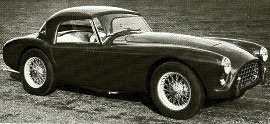 |
 |
AC Ace |
| |
Also see: AC Car Reviews |
| |
The AC Ace with hard-top joined the Ace open sport and Aceca models which were continued without material changes. The fibreglass hard-top was detachable. Approximately 90 per cent of AC cars were exported, mainly to the USA. |
|
 |
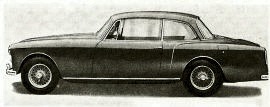 |
 |
Alvis 3-Litre TD21 Park Ward |
| |
Also see: Alvis Car Reviews |
| |
The Alvis 3-Litre TD21 Park Ward-bodied Saloon was distinguished from the TC1 08/G (Graber) version by a more curved bonnet top and nose, smaller one-piece rear window. number plate on the rear panel and revised frontal treatment. A Drophead Coupe version was also available. The 2993-cc engine was given a six-port cylinder head. new carburettors and a revised exhaust system early in the year. |
|
 |
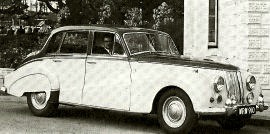 |
 |
Armstrong Siddeley Star Sapphire Six-light Saloon |
| |
|
| |
The Armstrong Siddeley Star Sapphire Six-light Saloon was similar in appearance to the Sapphire 346 except that it had cutaway rear wheel covers, doors hung on concealed hinges at the leading edges, a Sphinx mascot on the bonnet and different frontal treatment. The car featured a new 3·9-litre six-cylinder engine, automatic transmission, servo brakes (discs on the front) and power-assisted steering, all as standard equipment. |
|
 |
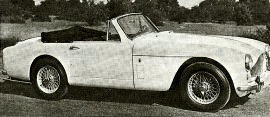 |
 |
|
| |
Also see: Aston Martin Road Tests and Reviews |
| |
The Aston Martin DBIII Drophead Coupe and Saloon were conntinued with modifications which included a hydraulic booster for the braking system and an alternative choice of-2922-cc-engine: a Special series engine with three SU carburettors or Competition engine with three Weber carburettors A Fixed-head Coupe with the Special series engine and twin exhausts as standard was added in the late spring, but by the autumn all three versions were discontinued. |
|
 |
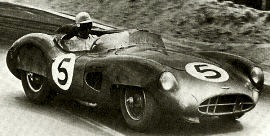 |
|
 |
 |
 |
|
| |
Also see: Aston Martin Road Tests and Reviews |
| |
The Aston Martin DB4 Saloon was a close-coupled four-seater, styled by Carrozzeria Touring of Milan and built by Tickford in England. The impressive car had a sloping roof which merged neatly into the tail that housed a completely separate luggage boot-the first post-war Aston Martin in which the boot did not link with the passenger compartment-and a traditional Aston Martin front end. The 3·7 -litre six-cylinder engine, which was a direct development from the 'Le Mans-bred' OBR2/370 unit, developed 240 bhp at 5500 rpm. |
|
 |
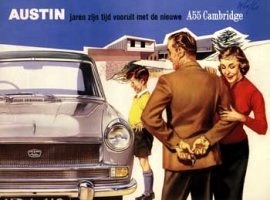 |
 |
Austin A55 Cambridge Mark II Farina Saloon |
| |
Also see: Austin Road Tests and Reviews |
| |
The Austin A55 Cambridge Mark II 'Farina' Saloon. This new Saloon - available in either standard or de luxe form - featured bodystyling by Pininfarina of Italy, using straight lines and finned rear wings. The well tried 1489-cc BMC B-Series engine, which was continued with a number of modifications, developed 53 bhp (gross) at 4350 rpm. A Countryman estate car version was added in the following year. |
|
 |
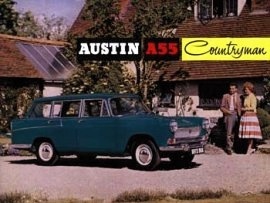 |
|
 |
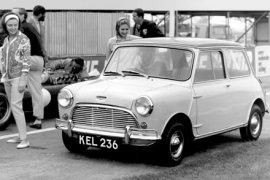 |
 |
Austin Mini |
| |
Also see: Austin Road Tests and Reviews |
| |
Hardly needs introduction as a design icon, but the original Mini's transversely-mounted front engine freed up a remarkable 80 percent of the tiny car's length for interior space. Groundbreaking stuff. |
|
 |
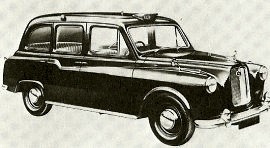 |
 |
Austin Taxi Model FX4D |
| |
Also see: Austin Road Tests and Reviews |
| |
The Austin Taxi, Model FX4D, was introduced in mid-1959. It had a redesigned body, a 2·2-litre diesel engine and optional automatic transmission. The Hire Car version was designated FL2D. |
|
 |
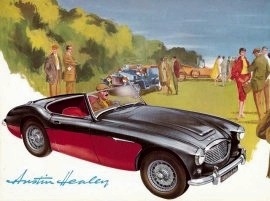 |
 |
|
| |
Also see: Austin Healey Road Tests and Reviews |
| |
The Austin Healey 3000 was introduced in 1959. The 2912 cc engine produced 132 hp which was later increased to 150 hp. It retained the detachable sliding windows; the Mk 2 was fitted with wind-up windows and a new windscreen arrangement. |
|
 |
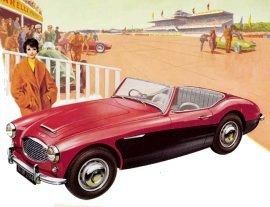 |
 |
|
| |
Also see: Austin Healey Road Tests and Reviews |
| |
The Austin-Healey 3000 Sports Roadster, Model BN7, superseded the 100 Six. It was distinguished by a '3000' flash on the horizontal slatted radiator grille and featured a larger (2912-cc) six-cylinder engine which developed 132 bhp (net) at 4750 rpm, a new front suspension system, and front disc brakes as standard. Also available was a two/ four-seater (BT7) version. |
|
 |
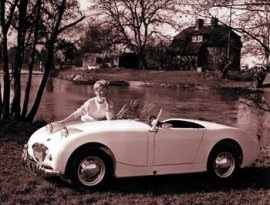 |
 |
|
| |
Also see: Austin Healey Road Tests and Reviews |
| |
In 1959 few sports cars were more endearing that
the Austin Sprite. It earned the nickname of " Frogeye"
due to its pop-eyed headlights and somewhat gaping grin. It captured the hearts of 3000 Healey enthusiasts all
over the world being a rather chirpy character on the
road with a top speed of 135 km/h. Assembled at Abingdon, it was based on a simple but
sturdy steel unit construction shell the Sprite had
immense character, acceptable performance, direct steering and good handling, all for a very (at the time) purchase
price. |
|
 |
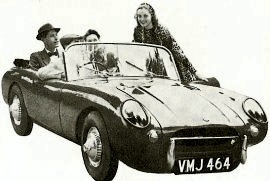 |
 |
Berkeley Foursome Sports |
| |
|
| |
The Berkeley Foursome Sports was developed from the 492-cc engined two-seater, and was introduced in the autumn of 1958. It was also available with hard-top. The two-seater models were continued under the Twosome label. By March 1959, however, the complete range was discontinued and replaced by a new model. |
|
 |
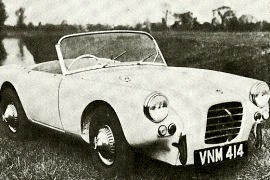 |
 |
Berkeley B95 Sports and Hard-top |
| |
|
| |
The Berkeley B95 Sports and Hard-top were powered by a Royal Enfield four-stroke two-cylinder 692-cc 40-bhp engine and externally differed from the earlier models mainly by the modified front. A B1 05 version, also available, had a higher performance engine (50 bhp at 6250 rpm). Larger-bodied versions (OB) were also made. |
|
 |
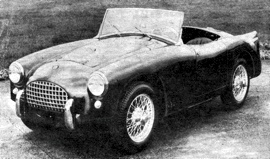 |
 |
BMC Turner Sports |
| |
|
| |
Orders for the little Turner sports car with the 948 c.c. B.M.C. A-type engine had, by 1959, kept the Wolverhampton works busy for nearly two years, during which time most of the output was shipped to the U.S.A. and South Africa. For the British home buyer, the car was sold in kit form, enabling do-it-yourself builders to escape the 60 per cent purchase tax on complete vehicles. Other good news for 1959, J. H. Turner began building for export a more powerful version with the Coventry Climax 1,098 c.c. engine. Brakes for all models were larger, and the body was modified slightly, with small fins on the rear wings. With Climax engine, a Turner was second in the 1958 Sam Collier Memorial Trophy Race in Florida.
Chassis frame has two large tubular side members and tubular cross members supporting girders to carry the floor and steel sheet underframe of the resin-bonded fibreglass body. Box section structures at the front carried the Austin A35 suspension, with coil springs and Armstrong piston-type dampers. The rigid rear axle was carried on trailing arms with transverse laminated torsion bars, an additional torque arm and a Panhard rod for lateral location.
With Climax engine in a mild state of tune giving 75 b.h.p. at 6,000 r.p.m., axle ratio was 4.22 to 1 instead of 4.55 with the B.M.C. engine and m.p.h. per 1,000 r.p.m. in top gear was 17.5. Brakes were upgraded to have 8 in. drums 11 in. wide, with two leading shoes at front. Instrument panel was upgraded in 1959 to include a speedometer and tachometer on all models. Cars with the B.M.C. engine could have two stages of tune employing twin SU carburettors to give 45-50 b.h.p. or 58-60. |
|
 |
 |
 |
Bristol 406 Saloon |
| |
Also see: Bristol Road Tests and Reviews |
| |
The Bristol 406 Saloon had a completely new aerodynamically styled two-door body-built by Jones of Willesden-as well as a larger 2·2-litre 105-bhp six-cylinder engine and servo-assisted disc-brakes all round. The luxurious interior included reclining seats with hinged headrests. |
|
 |
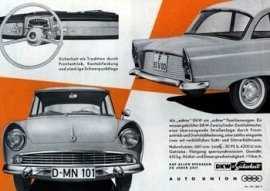 |
 |
DKW Junior |
| |
Also see: Auto Union Road Tests and Reviews |
| |
The DKW Junior prototype was first exhibited in 1957, and featured a two cylinder 660cc two stroke engine engine reminiscent of the two stroke engine last seen in the DKW F89 Meisterklasse phased out in 1953. A new manufacturing plant was constructed at the company's Ingolstadt location for production of the car, and by the time the Junior went into production, the prototype’s engine had been replaced by a three cylinder two stroke unit of 741 cc for which an output of 34 bhp (25 kW) was claimed. It is not clear whether the DKW Junior de Luxe, introduced in 1961, was intended to replace or to complement the original Junior which, in any case, was withdrawn in 1962.
The Junior de Luxe had its cylinders bored out: total displacement was now 796 cc. Claimed power output was unchanged but the torque was marginally increased and the wheel size grew from 12 to 13 inches. Claimed maximum speed increased from 114 km/h (71 mph) to 116 km/h (72 mph). In January 1963 the Junior De Luxe was replaced by the DKW F12. Outwardly there was little change, but the C pillar became more angular and the engine was enlarged to 889 cc which was reflected by a claimed increase in output to 40 bhp (29 kW). Apart from the engines, the big news from the F12 involved the brakes: the F12 was the first car in this class to be equipped with front disc brakes.
In August the Junior’s 796 cc engine reappeared in the DKW F11 which was in effect a reduced specification F12. The DKW F12 roadster which appeared in 1964 extracted 45 bhp (33 kW) from its 889 cc three cylinder engine, and this more powerful unit became available in the F12 saloon for a few months from February 1965. Early in the summer of 1965 Volkswagen acquired the Auto Union business from Daimler Benz: production of the two stroke DKWs was almost immediately terminated. In the market place the DKWs had been facing an increasing struggle to compete with similarly sized more powerful four stroke engined offerings from Volkswagen and, more recently, Opel. By the end of 1965 the plant formerly controlled by Auto Union was building Audi badged cars, with four cylinder four stroke engines designed, before the change of ownership, in collaboration with Mercedes-Benz.
|
|
 |
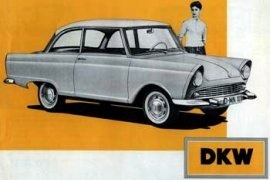 |
 |
DKW Junior |
| |
Also see: Auto Union Road Tests and Reviews |
| |
The DKW Junior was a small front wheel drive saloon manufactured by Auto Union AG. The car received a positive reaction when first exhibited, initially badged as the DKW 600, at the Frankfurt Motor Show in March 1957. The ‘Junior’ name was given to the (by now) DKW 750 in 1959 when the car went into volume production, but failed to survive an upgrade in January 1963, after which the car was known as the DKW F12. In addition to the saloon, a pretty ‘F12 Roadster’ (cabriolet version) was produced in limited numbers. The car was known for its two stroke engine. A number of European auto-makers produced two-stroke powered cars in the 1950s, but by the time the DKW Junior came along, the market was beginning to resist two-stroke powered cars as the industry increasingly standardised on four stroke four cylinder units which accordingly were becoming cheaper to produce. Two stroke engined cars were perceived by some as rough and noisy by comparison. |
|
 |
 |
 |
|
| |
Also see: Daimler Road Tests and Reviews |
| |
The fabulous Daimler SP250 Sports two-seater was announced in the spring of 1959, initially for export only with left-hand drive (SP250 LH Dart) and represented something of change for the Daimler company. The powerful 2½-litre V8 engine, which developed 140 bhp at 5800 rpm, made the car a particularly exciting performer. Disc brakes were standard, and overdrive or automatic transmission optional equipment. Wheelbase was 7 ft 8 in. |
|
 |
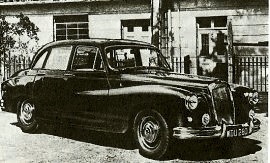 |
 |
|
| |
Also see: Daimler Road Tests and Reviews |
| |
The Daimler Majestic Saloon was similar in appearance to the One-O-Four but with increased body width, a lower radiator, smoother rear wing line and detail differences. The six-cylinder 3·8-litre engine developed 147 bhp at 4400 rpm. Automatic transmission and disc brakes were standard. |
|
 |
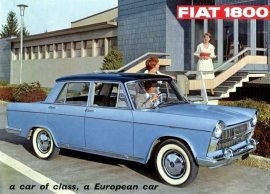 |
 |
Fiat 1800 |
| |
Also see: Fiat Road Tests and Reviews | Fiat Brochures |
| |
The Fiat 1800 appeared in 1959, offered as a 4-door sedan and a 5-door Station Wagon (Family). The 1800 model had a 6-cylinder in-line engine with 1795 cc and a power output of 75 hp / 55 kW delivered through a 4-speed transmission. Its maximum speed was, depending on the version, 137 km/h (85 mph) - 142 km/h (88 mph). This was replaced in 1961 with the 1800 model B: the engine output was now 81 hp / 60 kW and top speed between 143 km/h (89 mph) - 146 km/h (91 mph). |
|
 |
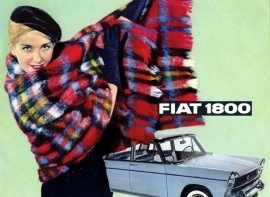 |
|
 |
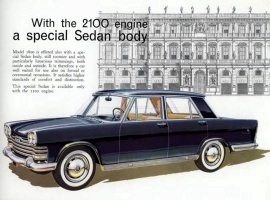 |
|
 |
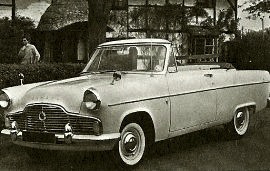 |
 |
Ford Consul, Zephyr and Zodiac Mark II |
| |
Also see: Ford UK Road Tests and Reviews |
| |
The Ford Consul, Zephyr and Zodiac Mark II models underwent a number of styling changes early in the year, including a lower roof line, stainless steel surrounds to windscreen and rear window cappings, chrome headlamp bezels, restyled rear lamp clusters and a modified facia layout. Pictured left is a Zephyr Convertible. |
|
 |
|
 |
|
| |
Also see: GAZ Road Tests and Reviews |
| |
The GAZ Chaika M13 was powered by a 195 horsepower (145 kW) 5.5 litre V8 driven through a push-button automatic transmission of a similar design to the Chrysler TorqueFlite unit. As a limousine-class car, Chaikas were available only to the Soviet government, and could not be purchased by the average Soviet citizen. For their larger size and more powerful V8, Chaikas were also ordered in some quantity by the KGB. Nikita Khrushchev, although entitled to a ZIL, was known to prefer Chaikas, and kept an M13 at his summer dacha. |
|
 |
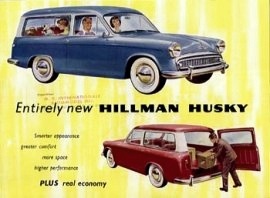 |
|
 |
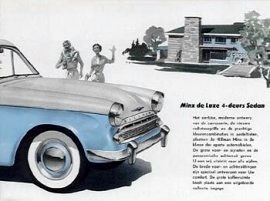 |
 |
Hillman Minx Series III |
| |
Also see: Hillman Road Tests and Reviews |
| |
The Hillman Minx Series III models featured a larger engine-1494-cc, 52·5 bhp (gross) at 4400 rpm-and differed externally from the Series II mainly by the revised radiator grille. Shown is the Special Saloon; also available were a De Luxe Saloon, Connvertible and Estate Car. The 1390-cc Husky Series I was continued unchanged. |
|
 |
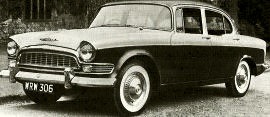 |
 |
Humber Super Snipe Series I |
| |
Also see: Humber Road Tests and Reviews |
| |
The Humber Super Snipe Series I was a new car, using the same body shell as the Hawk but with a distinctive radiator grille and winged bird motif on the bonnet. It was powered by a 105-bhp 2651-cc six-cylinder engine with a new three-speed gearbox and featured servooassisted brakes. Also available were Touring Limousine and Estate Car versions. All had 9 ft 2 in wheelbase. |
|
 |
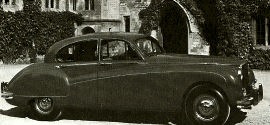 |
 |
Jaguar Mark IX Saloon |
| |
Also see: Jaguar Car Reviews and Jaguar - A Racing Pedigree |
| |
Although outwardly identical to the Mark VIII, except for the rear-end motif, the Jaguar Mark IX Saloon had numerous mechanical differences, including a larger six-cylinder engine-twin-carburettor, 3781 cc. 220 bhp-power engine, assisted steering, and disc brakes all round. Automatic transmission or overdrive were optionally available. |
|
 |
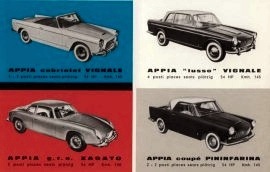 |
|
 |
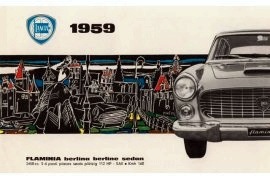 |
|
 |
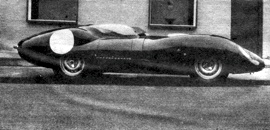
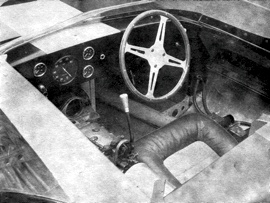 |
 |
Lister Jaguar |
| |
Also see: Jaguar - A Racing Pedigree |
| |
For 1959 the first result of a then new collaboration between Lister and Frank Costin was the smoothly streamlined body for the 1959 Lister Jaguar, showing the skilful drag reduction in which Costin was a world-renowned specialist following his work on Lotus and Vanwall. Works team drivers for 1959 were Ivor Bueb and Bruce Halford. The chassis was not greatly changed, except that Dunlop disc brakes of 12 in. diameter were adopted, so brakes, wheels and tyres all came from the same group.
The moulded screen and high tail was a logical development of those evolved by Costin for successful Le Mans Lotus cars and the passenger's side was covered with a new, patented cover. Solitary blister on the new body was over the Jaguar engine, which was mounted upright. An opening at the rear of the blister evacuated hot air from the engine compartment. Costin designs usually included a fully ducted radiator but in this case the only ducting was from nose entry to matrix; there was none aft. Cold air was taken from the relatively static region behind the front wheel well and drawn through the oil cooler by the depression in the cockpit.
Rear brakes were inboard (the axle was de Dion, as usual) and they were cooled by the same system as used on the Vanwall. Close fitting ducting "scrapes" the hot boundary layer of air from the surface of the disc and a large volume of cold air was projected at it from an intake in the under-tray. The seats were a new design by Cox, with soft raised edges to give comfortable lateral support. With reduced drag from the new body and 250 horsepower from the Jaguar 3.5-litre engine the Lister Jaguar could do over 180 m.p.h., and when powered by the 300 b.h.p. 3.8 litre unit the performance was brilliant.
ENGINE: 6 cyl., 83 x 306 m.m., 3,442 c.c. Compression 9:1, 250 b.h.p. at 6,000 r.p.m. Three twin choke Weber carburettors. On demand: engine, 3-litre, 83 x 92 m.m., 2,986 c.c.
TRANSMISSION: Three plate clutch. Four-speed gearbox. Power Lock differential unit (or ZF differential available at extra cost). Hypoid rear axle. Gear ratios 7.61, 5.825, 4.525, 3.54:1. Other ratios between 4.78 and 2.83:1.
BRAKES: Dunlop disc, 12 in. diameter.
SUSPENSION: Front, equal length wishbones and coil springs; Rear, de Dion and coil springs. Telescopic shock absorbers.
TYRES: Front, 6.00 x 16; rear, 6.50 x 16.
DIMENSIONS: Wheelbase, 7 ft. 63 in. Track, front 4 ft. 4 in.; rear, 4 ft. 5i in. Length, 14 ft. 41 in. Width, 5 ft. 7 in. Height, 2 ft. 7 in. at scuttle; overall height, 3 ft. 2 in. Ground clearance, 6 in. Turning circle, 40 ft. Dry weight, 1,736 lb. Tank, 38 Imperial gallons. |
|
 |
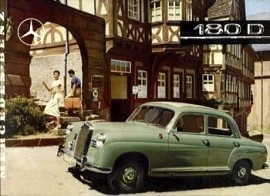 |
|
 |
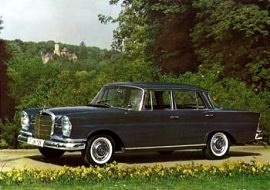 |
|
 |
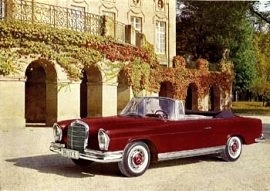 |
|
 |
 |
|
 |
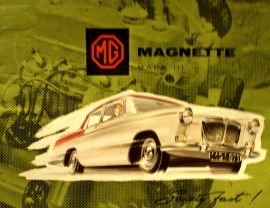 |
|
 |
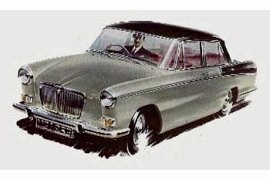 |
|
 |
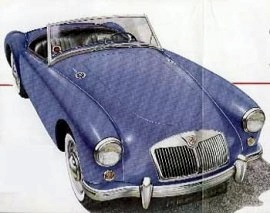 |
|
 |
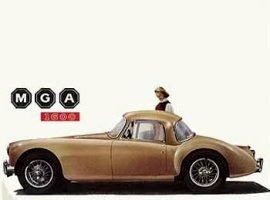 |
|
 |
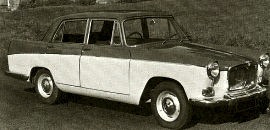 |
 |
MG Magnette Mark III Farina Saloon |
| |
Also see: MG Road Tests and Reviews | MG Brochures |
| |
The MG Magnette Mark III 'Farina' Saloon succeeded the Magnette ZB Saloon early in the year. As with the other BMC models in this class the body was styled by Pininfarina ; it was distinguishable mainly by its traditional MG radiator grille. The 1½-litre engine had twin carburettors and developed 66·5 bhp at 5200 rpm. |
|
 |
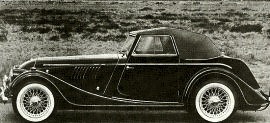 |
 |
Morgan Plus Four Drophead Coupe |
| |
Also see: Morgan Road Tests and Reviews |
| |
The Morgan Plus Four Drophead Coupe was continued with a number of changes which included the spare wheel recessed in the sloping tail, a rear-mounted 12-gallon fuel tank, and narrower running boards. These modifications also applied to the two-seater Tourer. The four-seater Tourer was also continued. Disc brakes became optional on all models. |
|
 |
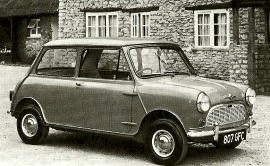 |
 |
Morris Mini-Minor Saloon |
| |
Also see: Morris Road Tests and Reviews |
| |
The Morris Mini-Minor Saloon quickly became an incredibly successful little car, and was officially announced in August 1959, although the eager motoring press had previously sampled its delights in the spring of that year. The brain child of Alec Issigonis it featured a simple but practical two-door body with a 10 in. wheel at each corner, a transversely-mounted 848-cc 34-bhp (net) engine, four-speed gearbox, front-wheel drive and all-independent rubber cone-spring suspension.
Also available was an Austin version-then called the Seven, which was distinguishable by its different grille. Both versions were available in basic and de luxe forms, priced at £497 and £537 resp, (lncl, PT). The Austin version's name was sometimes spelled as Se7en but before long both were universally referred to as 'Mini'. |
|
 |
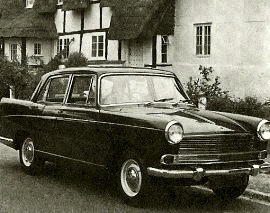 |
 |
Morris Oxford Series V Farina |
| |
Also see: Morris Road Tests and Reviews |
| |
The Morris Oxford Series V 'Farina' was identical to the Austin A55 Cambridge except for radiator grille design, detail body fittings, badges and interior layout. With detail modifications it remained in production - in Saloon and Traveller form - until 1971. |
|
 |
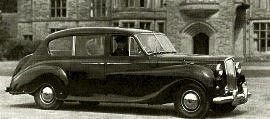 |
 |
Princess Long-wheelbase Special Equipment Limousine |
| |
Also see: Austin Road Tests and Reviews |
| |
This Vanden-Plas bodied luxury Austin model (Princess Long-wheelbase 'Special Equipment' Limousine) was similar to the long-wheelbase Limousine, but included as standard fitments: automatic transmission, power steering, electrically-operated division, footrests and mohair rugs in rear compartment and an electric clock and cigar lighter for the rear-seat passengers. |
|
 |
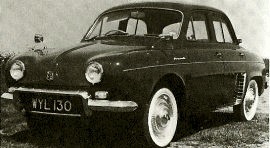 |
 |
|
| |
Also see: Renault Road Tests and Reviews | Renault Brochures |
| |
The Renault Dauphine Saloon, Model R1090, was announced in France in the autumn of 1955. Iit was also assembled in the UK, at Acton, from the Summer of 1956. It was a rear-engined four-door four-seater powered by a bored-out 845-cc 30-bhp derivative of the 4CV engine and featured a unitary body-cum-chassis, three-speed gearbox and all-independent suspension. Modifications for 1959 included a raised compression ratio and a thermostatic control for the heater.
|
|
 |
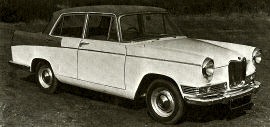 |
 |
Riley 4/Sixty-Eight Saloon |
| |
Also see: Riley Road Tests and Reviews |
| |
The Riley 4/Sixty-Eight Saloon was one of the new BMC 1½-litre 'Farina' range of models. It was mechaniccally similar to the MG Magnette Mark III, but was easily distinguishable by its traditional Riley-style radiator grille. |
|
 |
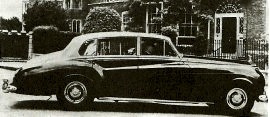 |
 |
|
| |
Also see: Rolls-Royce Road Tests and Reviews |
| |
The RolIs-Royce Silver Cloud Long-Wheelbase Saloon was a Park Ward conversion of the elegant steel saloon, lengthened to suit the 4-inch increase in wheelbase. The car was designed for dual-purpose use viz. as a limousine, chauffeur driven, with the electrically-operated glass division raised, as well as for holiday/pleasure motoring when the division could be lowered. The side windows were also electrically-operated. |
|
 |
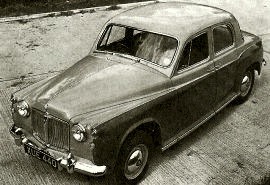 |
 |
|
| |
Also see: Rover Road Tests and Reviews | Rover Brochures |
| |
The Rover 60 or Sixty P4 Saloon was continued with detail modifications which included a modified grille and a redesigned rear number plate mounting. These changes also applied to the 75, 90 and 105 models - the 105R had been discontinued in the summer of 1958 and the 105S became known as the 105 until it was also dropped, later in 1959. |
|
 |
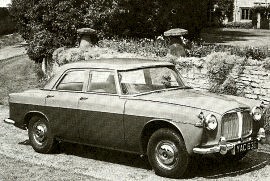 |
 |
|
| |
Also see: Rover Road Tests and Reviews | Rover Brochures |
| |
The Rover 3-Litre (P5) Saloon was the first Rover to have a unitary body-cum-chassis structure, albeit with a front sub-frame. It was noticeably longer, lower and wider than the other Rover Cars and featured a six-cylinder 2995-cc 115-bhp engine, four-speed gearbox and servo-assisted brakes. The front and rear bench seats had folding arm rests and were trimmed throughout in leather; separate front seats were optional. |
|
 |
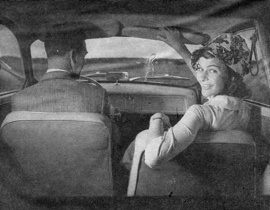 |
 |
SAAB 93 Saloon |
| |
Also see: SAAB Road Tests and Reviews |
| |
For 1959, the Swedish two-stroke Saab 93 B saloon was improved, the basic design remaining unchanged. The car was built by Svenska Aeroplan AB of Linkoping, the famous aircraft firm. The 93 had been in production since 1955, and updates in 1958 included a new one piece windscreen and several other modifications. For 1959 the changes were less conpicuous and the keynote was safety. Engine output was still 38 b.h.p. at 5,000 r.p.m. but the brakes in front were increased in size. The drums were now of 9 in. diameter, compared with 8 in. on the previous models. Total rubbing area was now 675 square c.m.
Another safety detail was the fitment of asymmetric headlights and windscreen washing equipment as standard. The sunvisors were of a new type, making them less dangerous in the event of a crash. The material used in the visors was impact absorbing and soft. For the engine, there was a new air filter unit. The new filter was of the efficient paper type, easy to replace and cheaper than the previous one. The Saab 93 B was well received in Sweden and the car as successful from a sales point of view as the previous 93. The number of cars exported had been rising, and the U.S. market in particular flourished during 1957 and 1958. |
|
 |
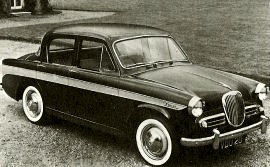 |
 |
|
| |
Also see: Singer Road Tests and Reviews |
| |
The 1959 Singer Gazelle Series III Saloon was distinguishable from the Series I1 version by the reshaped body side-flashes, with 'Gazelle' located on the top of each flash near the headlamps. Convertible and Estate versions were also available. |
|
 |
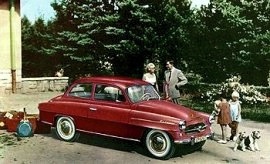 |
 |
Skoda Octavia |
| |
Also see: Skoda Road Tests and Reviews |
| |
The Skoda Octavia was introduced in January 1959, being the successor to the Škoda 440/445 on which it was based. The new Skoda was given the name "Octavia" as it was the eighth car produced by the nationalised Skoda company. The saloons would remain in production until 1964, when they were replaced by the Škoda MB1000/1100. The Octavia featured redesigned front axles with a coil spring and telescopic shock absorbers rather than a leaf spring as in the 440.
The 1270 kg (2800 lb) saloons were sold with 1089 cc engines producing 40 bhp (30 kW), later 50 bhp (37 kW), and 1221 cc engines with 45-55 bhp (34-41 kW). The slightly heavier estates weighed in at 1365 kg (3009 lb), and were all shipped with 1.2 litre engines. The top speed was 110-115 km/h (68-71 mph). |
|
 |
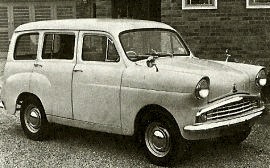 |
 |
Standard Ten Companion Estate |
| |
Also see: Standard Road Tests and Reviews |
| |
The Standard Ten Companion Estate was continued with a number of styling changes which included a grille of three horizontal bars incorporating combined sidelights and flashing trafficators, and wings which were extended to form hoods for the headlamps. |
|
 |
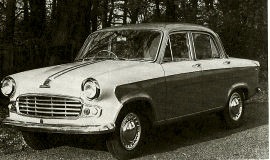 |
 |
Standard Vanguard Vignale Saloon |
| |
Also see: Standard Road Tests and Reviews |
| |
Although the Standard Vanguard Vignale Saloon was mechanically similar to its predecessor - the Vanguard Phase Ill - this new model featured subtle body changes made by the Italian stylist Michelotti (in conjunction with Vignale). including a higher roof line, larger windows, a new radiator grille flanked by front lights set in chrome extensions, and modified rear light clusters. The Vanguard Estate Car featured similar changes. |
|
 |
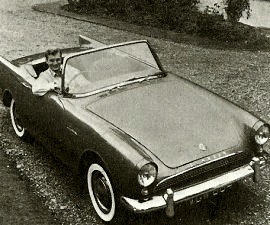 |
 |
|
| |
Also see: Sunbeam Road Tests and Reviews |
| |
The Sunbeam Alpine was an attractive new two-seater high-performance open sports car, featuring a number of components developed from those of the Sunbeam Rapier, including a 1494-cc twin-carburettor 78-bhp engine and independent coil spring and wishbone front suspension. When not in use the folding hood disappeared completely into a recess behind the rear 'occasional' seat. White-wall tyres and wire spoke wheels were optional extras, as was a detachable hard-top. |
|
 |
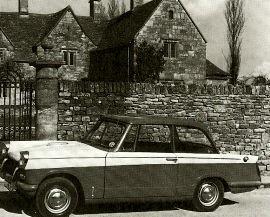 |
 |
|
| |
Also see: Triumph Road Tests and Reviews |
| |
The Triumph Herald Saloon was styled by the Italian Giovanni Michelotti. Highly successful, it included many interesting and desirable features, such as all-independent suspension, a turning circle smaller than that of a London taxi cab, a chassis without greasing points, and an all-steel body, the front section of which was hinged at the forward end to give easy access to the engine, steering gear and front suspension. The 948-cc engine and gearbox were similar to those of the Standard Ten. Also available was a Coupe version which featured a twinburettor 948-cc engine and a sloping roof line. A Convertible was launched in 1960. |
|
 |
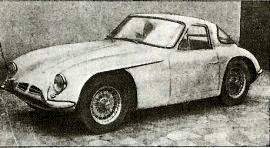 |
 |
TVR Grantura Sports Coupe / Jomar |
| |
Also see: TVR Road Tests and Reviews |
| |
The TVR Grantura Sports Coupe (Jomar) was introduced onto the British market early in 1959, following a successful four-year tie-up between two Blackpool engineers, Trevor Wilkinson and Bernard Williams, and an American, Ray Saidel, during which time a number of these cars - and early models -achieved successes in American sports car events. It featured fibreglass bodywork and a choice of three power-units: Coventry Climax FWE 1216-cc (as on the Lotus Elite), Ford 100E standard or Ford 100E Super-charged. In America the car was known as the Jomar. |
|
 |
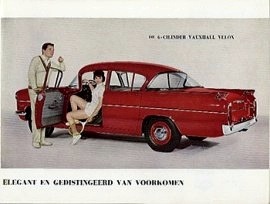 |
 |
Vauxhall Velox |
| |
Also see: Vauxhall Road Tests and Reviews |
| |
The Velox PA received its first facelift in October 1959 when the front grill was enlarged and the three piece rear window was replaced by a single wrap-around window. Technical improvements had to await the 1960 facelift. |
|
 |
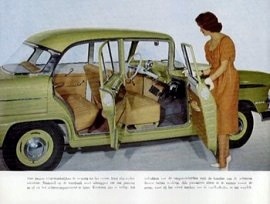 |
 |
Vauxhall Victor |
| |
Also see: Vauxhall Road Tests and Reviews |
| |
The 1959 Vauxhall Victor Series II Saloon replaced the original edition early in the year. It was distinguishable mainly by smooth rear-door panels, full-width radiator grille with protruding oval sidelights, smooth wrapround bumpers and a reshaped bonnet. |
|
 |
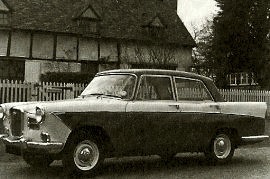 |
 |
Wolseley 15/60 Saloon |
| |
Also see: Wolseley Road Tests and Reviews |
| |
The Wolseley 15/60 Saloon was fifth in the new BMC 1½-litre 'Farina' range and had a traditional radiator grille with illuminated name badge, flanked by horizontal air inlets. It was basically similar to the Austin A55 and Morris Oxford Series V, but not available in estate car form. |
|
 |
|
 |
ZIL 111 |
| |
Also see: ZIS / ZIL Road Tests and Reviews |
| |
The ZIL-111 was to remain in limited series production for 10 years. Production was limited because other cars and minibuses for taxi and ambulance service became available and because another car called the Chaika (seagull) was introduced by the Gorky Automobile Works. The "One-Eleven" would be improved and updated on a number of occasions. The ZIL-111 A got Russia's first car air-conditioning unit, and the ZIL-111 V was fitted with an open body and an electrically operated soft-top. |
|
|
|
Sell Your Car or Parts
Browse the Classifieds
It's Absolutely Free! - Find Out More
|
|



